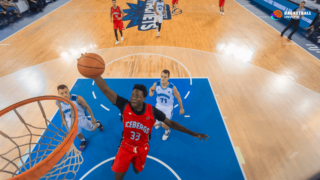
Are you eager to expand your basketball knowledge and dive into the world of strategic defensive plays? Well, buckle up as we explore the fascinating 1-3-1 trapping defense in basketball! Used by both collegiate and professional coaches, this unique and aggressive defensive scheme wreaks havoc on opposing offenses, causing turnovers, confusion, and forcing teams to adapt on the fly. As you immerse yourself in this exciting basketball concept, your understanding of the game will reach new heights, making you the go-to expert amongst your friends or team. Now, let’s break down the nuances of the 1-3-1 trapping defense and discover what makes it such a formidable slam-dunk strategy!
What’s a 1-3-1 Trapping Defense in Basketball?
A 1-3-1 trapping defense is a strategic defensive formation in basketball, characterized by one player at the top of the key, three players positioned across the middle, and one player near the baseline. It emphasizes aggressive trapping, forcing turnovers through double-teaming ball handlers in specific areas of the court while maintaining balance and coverage on the rest of the offensive players. This defense is particularly effective at disrupting rhythmic offensive plays, and ultimately creating scoring opportunities through forced mistakes.
Unlocking the Secrets of the 1-3-1 Trapping Defense
In this in-depth exploration of the 1-3-1 trapping defense, we’ll take a deep dive into the mechanics, the roles of the players, specific trapping methods, and strategies to counteract it. By the end of this journey, you’ll be well-equipped with everything you need to know about this basketball defensive scheme, ready to implement or decode it on the court. Let’s get started!
Understanding the Mechanisms Behind the 1-3-1 Trapping Defense
One key to mastering the 1-3-1 trapping defense is understanding how it operates within the basketball framework. The scheme places emphasis on controlling the tempo, dictating the offensive flow, and generating forced turnovers, which can quickly turn into fast-break opportunities for your team. Here, we’ll break down the crucial aspects of this defense and the specific trapping methods used.
Trapping Zones and Defensive Rotation
The court is divided into specific trapping zones where double-teams, or “traps,” are executed. These zones are typically by the sidelines and in the corners, which allows the defenders to use the baseline and sideline as additional defenders. When a ball handler enters a trapping zone, two defenders converge to apply pressure, aiming to disrupt the offense and force turnovers.
Defensive rotation is crucial within the 1-3-1 trapping defense. As two defenders converge to trap the ball handler, the other three defenders must rotate to cover the exposed areas and anticipate any potential offensive passes. This well-coordinated nature of the 1-3-1 trapping defense is what makes it such a challenging defensive scheme to counter.
Active Hands and Quick Feet
As players in the 1-3-1 trapping defense, being proactive with hand and foot movement is vital to the success of the scheme. Active hands make it difficult for the ball handler to see passing lanes or even attempt a shot, increasing the likelihood of turnover opportunities. Quick foot movement is essential for effectively closing out on shooters, stealing passes, or recovering to your designated area on the court.
Discovering the Roles of Each Player
Each position in the 1-3-1 trapping defense plays a specific role, with their responsibilities and objectives integrated seamlessly into the overall game plan. Understanding these roles is imperative to implementing this defense effectively on the basketball court.
The Top Defender
The top defender is typically the quickest and most agile player on the team. Their main responsibilities include:
- Applying pressure on the ball handler
- Initiating traps along the sideline
- Contesting passes to the wings and corners
- Preventing interior passes or penetration
The top defender sets the tone for the entire defense and is responsible for aggressively pressuring the ball handler in a way that funnels them towards the trapping zones.
The Wing Defenders
The wing defenders are usually tall and athletic players with excellent lateral speed. They’re crucial to the overall effectiveness of the trapping scheme, as they must be able to close out, recover, and rotate quickly. Their main responsibilities include:
- Participating in sideline traps
- Covering passing lanes to disrupt the offense
- Defending shots from the perimeter
- Helping with interior defense when necessary
Their versatility enables the 1-3-1 defense to be aggressive on the perimeter while maintaining a strong interior presence.
The Middle Defender
The middle defender tends to be a taller, intimidating player who can cover ground quickly. Their main responsibilities include:
- Protecting the basket as the last line of defense
- Contesting interior shots or passes
- Helping on sideline traps and quick rotations
- Securing rebounds after forced misses
The middle defender acts as the anchor to the defensive scheme, ensuring the defense remains balanced and ready to retaliate when turnovers are forced.
The Baseline Defender
The baseline defender is often a long and athletic player who can cover the entire baseline with quick lateral movements. Their main responsibilities include:
- Guarding the offensive baseline player
- Anticipating skip passes and intercepting them
- Helping to defend corner three-point shots
- Rotating and recovering in coordination with the other defenders
It’s crucial for the baseline defender to read the offense accurately, as they are responsible for guarding a large area of the court alongside other defenders.
Finding Success with Specific Trapping Techniques
Now that you’re familiar with the mechanics and player roles within the 1-3-1 trapping defense, let’s delve into the various trapping methods that make this defense so formidable in basketball. Mastering these techniques will help you disrupt the offense and generate more turnovers for your team.
Sideline Traps
Sideline traps are the bread and butter of the 1-3-1 trapping defense. As the ball handler is funneled towards the sideline by the top defender, the wing defender sprints to converge and double-team the ball handler. The remaining three defenders rotate accordingly based on their position, reading the offensive players’ movements and anticipating potential passes.
Corner Traps
With corner traps, the top and wing defenders force the ball handler into the corner of the court. The wing defender traps the ball handler while the top defender denies them any passing options to the perimeter. The baseline defender aggressively anticipates and intercepts skip passes across the court, and the middle defender focuses on interior protection and potential pass interception.
Full-Court Press Variation
One popular variation of the 1-3-1 trapping defense is implementing it as a full-court press. This aggressive approach increases pressure on the ball handler from the moment they inbound the basketball, causing the offense to work even harder to advance the ball down the court. The full-court press can be particularly useful as a surprise tactic, catching the opposing team off-guard and causing turnovers early in the possessions.
Countering the Threat of the 1-3-1 Trapping Defense
Having a thorough understanding of the 1-3-1 trapping defense also equips you with the knowledge to counteract it. By getting to know the weak points, proper spacing, and effective ball movement, you’ll be better prepared to attack this defense as an offensive strategist.
Pause, Don’t Panic
With the aggressive nature of this defense, the first rule for attacking the 1-3-1 trapping defense is to pause and not panic. Encourage ball handlers to maintain composure and attack the defense intelligently. Hasty decisions can lead to turnovers, which are exactly what the defense is hoping for.
Proper Offensive Spacing
Maintaining proper spacing between offensive players is crucial for success against a 1-3-1 defense. This spacing can create opportunities to exploit defensive rotations and find open teammates for clear passing lanes or uncontested shots. Popular offensive alignments include a 1-3-1, a 1-2-2, or a 2-1-2 formation, creating proper spacing and alignment to counteract the trapping defense.
Ball Reversals and Skip Passes
Quick and accurate ball movement can dismantle the 1-3-1 trapping defense by forcing defenders to constantly be on the move and exploitable. Ball reversals, wherein the ball is quickly swung from one side of the court to the other, can create scoring opportunities by shifting the entire defense. In addition, skip passes – which are thrown over the defenders to an open teammate on the opposite side – can catch the rotating defenders out of position, leading to open shots or easier entry passes into the post.
Attack the Middle
Getting the basketball into the high post or the middle of the defense can severely disrupt the 1-3-1 trapping scheme by engaging the middle defender, making them choose between protecting the rim and sticking with their primary assignment. Ball movement to the middle of the defense can open up opportunities for short jumpers, kick-outs to shooters, or easy layups.
A Final Word on the 1-3-1 Trapping Defense in Basketball
Now armed with a comprehensive understanding of the 1-3-1 trapping defense in basketball, you are well-equipped to implement this defensive scheme or dissect it with a keen offensive mindset. Remember, the success of this defense heavily depends on the synergy between the players, their athleticism, communication, and their decisiveness when it comes to timing and rotations. When implemented and mastered, the 1-3-1 trapping defense can be an absolute game-changer, transforming the dynamics of basketball games and
Adapting and Evolving with the 1-3-1 Trapping Defense
The game of basketball is ever-changing, and so are its players and strategies. As you continue to develop your understanding of the 1-3-1 trapping defense, it’s crucial to consider how to adapt and evolve with the game. Here, we’ll share essential tips and insights to help you refine your basketball knowledge and get the most out of implementing or contesting the 1-3-1 trapping defense.
Success Factors for the 1-3-1 Trapping Defense
There are several critical aspects of the 1-3-1 trapping defense that coaches and players should focus on for effective execution. Some of these factors include:
Effective Communication
Consistent and clear communication between players is paramount for the success of any defensive scheme, especially in the 1-3-1 trapping defense. Players need to talk and relay information about the opponents’ positions, movements, and intentions. It helps in executing efficient traps, maintaining defensive rotations, and allowing swift recoveries.
Athleticism and Versatility
As previously mentioned, the 1-3-1 trapping defense relies on speed, agility, and length of the players. A roster featuring versatile and athletic individuals can significantly increase the success rate of this defensive strategy, allowing them to cover large portions of the court and close down passing lanes quickly.
Reading and Reacting
Players within the 1-3-1 trapping defense must be adept at reading and reacting to the offensive flow. Understanding an opponent’s movements and tendencies can improve decision-making, allowing defenders to anticipate actions and execute well-coordinated traps and rotations.
Adjustments to Counter Offensive Strategies
Opposing teams will likely devise offensive strategies specifically tailored to exploit weaknesses within the 1-3-1 trapping defense. Being able to adjust and modify the defensive game plan on the fly is crucial for maintaining the element of surprise and countering these game plans effectively.
Modifications Based on Player Matchups
Depending on the opposing team’s players, coaches may need to make slight adjustments to roles within the 1-3-1 defense to neutralize specific matchups. For example, when facing a prolific three-point shooter, coaches might instruct wing defenders to close out more aggressively on the shooter, even at the expense of leaving other areas more exposed.
Tempo Management
Coaches must know when to change the defensive tempo or switch to different defensive schemes to keep the offense guessing. Utilizing the 1-3-1 trapping defense at opportune moments or in tandem with other defensive formations can maximize its effectiveness.
Incorporating Drills to Reinforce the 1-3-1 Trapping Defense
Integrating drills that specifically target the development of 1-3-1 trapping defense skills is vital for improving team execution. Some essential drills and exercises include:
Trapping Drills
Conducting two-on-one and three-on-two trapping drills is an excellent way to enhance the players’ ability to execute traps and force turnovers. These drills hone in on effective trapping techniques such as body positioning, active hands, and communication.
Defensive Rotation Drills
Shell drills focusing on rapid defensive rotations are invaluable for establishing the understanding and coordination needed to execute the 1-3-1 defense. These drills incorporate contests, closeouts, and recoveries, simulating game scenarios for players to read and react.
Conditioning and Agility Drills
Improving players’ stamina, speed, and agility can further bolster the success of a 1-3-1 trapping defense. Coaches should incorporate conditioning and agility drills that simulate the necessary movements and quick changes of direction, ultimately preparing the players for the physical demands of this aggressive defensive scheme.
By embracing adaptability, constantly refining techniques, and incorporating the right drills and strategies, you can take your understanding and execution of the 1-3-1 trapping defense in basketball to new heights.
FAQ – Frequently Asked Questions about the 1-3-1 Trapping Defense
Still have questions about the 1-3-1 trapping defense? Don’t worry, we’ve got you covered! Below are some of the most frequently asked questions and their answers, serving as a helpful resource to deepen your understanding of this fascinating defensive strategy in basketball.
Who should play each position in the 1-3-1 trapping defense?
The top defender is typically the quickest and most agile player on the team, wing defenders are usually tall and athletic players with great lateral speed, the middle defender is typically tall and intimidating with good movement, and the baseline defender is often a long and athletic player capable of covering the entire baseline.
Is the 1-3-1 trapping defense suitable for all levels of play?
Yes, the 1-3-1 trapping defense can be effective across various levels of basketball, from youth leagues to professional sports, as long as the whole team understands the roles, responsibilities, and rotations it requires.
When should a team use the 1-3-1 trapping defense?
Coaches often implement the 1-3-1 trapping defense as a surprise tactic, when the team is in need of a momentum shift, or when the composition of the opposing team’s roster can be exploited using this scheme.
How does the 1-3-1 trapping defense compare to man-to-man defense?
While man-to-man defense focuses on individual matchups, the 1-3-1 trapping defense relies on collective effort, aggressive trapping, and coordination, making it a more dynamic and unpredictable defensive scheme.
What are the disadvantages of the 1-3-1 trapping defense?
The 1-3-1 trapping defense can be vulnerable to proper offensive spacing, precise ball movement, and accurate shooting, as well as requiring high levels of communication, athleticism, and coordination among the team members.
How can a team prepare for facing the 1-3-1 trapping defense?
To prepare, a team should work on maintaining composure, setting up proper offensive spacing, practicing quick and accurate ball movement, executing ball reversals and skip passes, and attacking the middle of the defense.
How can a team become more effective in executing the 1-3-1 trapping defense?
Teams can improve their effectiveness by focusing on communication, athleticism, adaptability, reading and reacting to the offense, and incorporating drills that specifically target the development of 1-3-1 trapping defense skills.
What is a full-court press variation of the 1-3-1 trapping defense?
A full-court press variation of the 1-3-1 trapping defense extends the trapping zones and pressure to the entire length of the court, forcing the offense to work harder to advance the ball from the inbound pass.
Can the 1-3-1 trapping defense be combined with other defensive schemes?
Yes, the 1-3-1 trapping defense can be mixed with other defensive schemes—such as man-to-man or a 2-3 zone defense—depending on the opponent’s offensive strategies and the need to vary the defensive approach during a game.
What type of drills are useful for enhancing the players’ abilities within the 1-3-1 trapping defense?
Drills focusing on trapping, defensive rotations, conditioning, and agility, as well as shell drills and situational simulations, are all essential exercises to help players develop skills required for the 1-3-1 trapping defense.
Featured Posts
- No pillar pages found.





